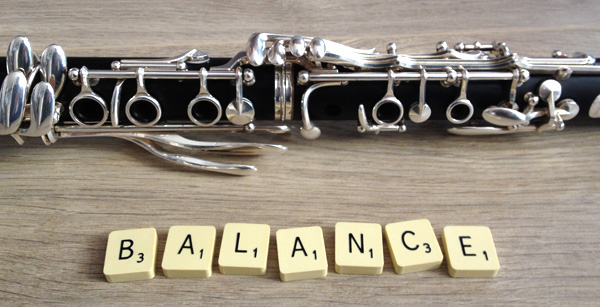7 Things every musician needs to know to overcome tension, minimize pain, and maximize ease in performance.

#1. Balance is important in every aspect of music making.
Here are two of my favorite definitions of balance:
- a state of equilibrium or equipoise; equal distribution of weight, amount, etc.
- A harmonious or satisfying arrangement or proportion of parts or elements, as in a design.
You balance your instrument, you balance the velocity of your wind or your bow, you balance dynamics, you balance your practice sessions between warm ups and repertoire, etc. But do you balance your primary instrument — your body? Balance is not about having perfect “posture” when you play. A posture implies a fixed place, a position, a pose or a stance. This is not what you want if you are about to move — and music is all about movement. We all know the unpleasant result when the musical line is static and not moving from one place to another place. The same is true of your body. Balance in your structure allows for free and easy movement, which transfers directly to the quality of sound you make on your musical instrument.
Do you suffer neck and shoulder tension and/or pain in your lower back when you sit or stand to play? Begin by taking a good look at how you balance your head on your spine. Perhaps your head is slightly forward, leaning in towards your instrument. Or perhaps your head protrudes forward towards the music, in an effort to see it more clearly — decipher the notes, rhythms, etc.. If you are collapsed around your naval or at the “waist”, the back of your head will pull down and back, you will feel shortening and compression in the back of your neck, and your chin will jut forward. Try it a few times to experience this uncomfortable sequence of actions. Remember that you can always reverse it to come back to balance!

Activity: the next time you practice, set up your smart phone and make a video from the side. Play long enough to get involved in the music so you can forget about the video. For this activity do not worry about mistakes or attempt to create the polished product you would send off for an audition. We will experiment with that another time — so for now take that pressure off yourself! You are simply observing what you SEE when you play. Save the video so you can compare it to future videos, once you have learned to properly balance your head on your spine.
Part two of this blog series will go into more detail about how to experience and continually renew the head-spine balance relationship, as well as other places of balance throughout the your primary instrument — you body.
By joining the email list in the form below, you will be guaranteed to receive all 7 blogs in this series, PLUS a FREE online mini lesson with me! In this lesson you might or might not even play a note, but we will take a look at how you set up to play your instrument, and how the balance of your body with your instrument will improve your sound and reduce or even eliminate tension. I encourage you to provide any additional information you would like me to have in the comments section below.
Your message has been sent

Comments
7 Things every musician needs to know to overcome tension, minimize pain, and maximize ease in performance. — No Comments
HTML tags allowed in your comment: <a href="" title=""> <abbr title=""> <acronym title=""> <b> <blockquote cite=""> <cite> <code> <del datetime=""> <em> <i> <q cite=""> <s> <strike> <strong>